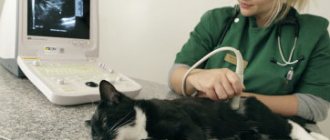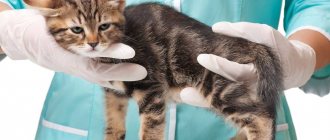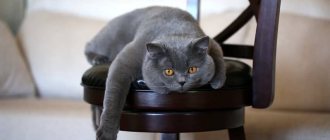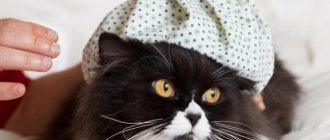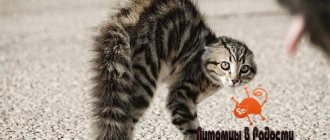Tripelphosphates - what is it and why are they dangerous?
Tripelphosphates in a cat's urine can only be detected in a veterinary laboratory by microscopic examination of the sediment or x-ray examination using a contrast agent. Considering the fact that not every pet owner has an idea of the mechanism of development of urolithiasis, it is worth understanding what tripel phosphates are and how they are dangerous for the animal.
Under the influence of a number of reasons, the metabolism in the cat’s body changes, urine becomes alkalized and ammonium salts of magnesium phosphate precipitate in the form of sand. Subsequently, in an alkaline environment, crystallization occurs and the rapid growth of phosphate stones occurs, which within a few days can fill the entire kidney of the animal. While tripelphosphates are in the kidney, they do not cause any disturbance to the pet due to their smooth, porous surface.
But with the flow of urine, stones enter other organs of the urinary system : ureters, bladder and urethra. The main danger of stones is that they block the urethra, causing the body to lose the vital need to excrete urine.
Stagnation of urine occurs, stretching of the walls of the bladder and rupture of blood vessels, as a result of which urine toxins enter the blood, causing poisoning of the entire body. Under the influence of toxins, the functioning of the cardiovascular, respiratory, digestive and nervous systems is disrupted, a coma occurs and the animal dies in agony.
Prevention
Prevention of tripelphosphate deposition involves a balanced diet and urine pH control. The analysis is recommended to be carried out 2 times a year; a veterinarian will help you choose the right diet for your pet. It is recommended to include in the cat's diet products that help remove stones and sand from the bladder: boiled vegetables, decoctions of parsley, bear's ear.
An active lifestyle is also important: movement prevents the development of obesity and does not allow salts dissolved in urine to crystallize and combine into conglomerates. Stones in the urine are formed if the animal “suffers” and does not empty its bladder on time. And since many cats are disdainful of using a toilet that smells bad, the owner needs to make sure that the litter box is clean.
You can also contact our site's staff veterinarian, who will respond to them as soon as possible in the comment box below.
Rules for collecting urine from cats
The main way to detect tripelphosphates is urine analysis, but the reliability of its results depends on the correctness of the analysis, storage conditions and time of delivery of the sample to the veterinary laboratory.
Rules for collecting urine from cats:
- For analysis, it is necessary to bring an average portion of morning urine collected immediately after a night's sleep.
- The external genitalia of your pet must be thoroughly washed with boiled water and laundry soap and dried well with a towel.
- The tray should also be treated with laundry soap and boiling water; it is not recommended to use chemicals to disinfect it, as they can negatively affect the results of laboratory tests.
- A special non-absorbent filler or plastic bag must be placed in the tray, from which urine must be collected with a sterile syringe.
Symptoms
Most often, the fact that a cat's urine contains tripelphosphates is discovered by chance during an examination for another reason or during a routine examination and testing. Symptoms of the pathological condition appear only when the disease has already progressed far (began to swell) and significant stones have formed. In such a situation, the main manifestations of the disease are
:
- decreased appetite in the cat, which gradually leads to a complete refusal of food;
- depression - the cat begins to refuse even its favorite games and communication with people, even if up to this point it was active and sociable;
- frequent visits to the litter box, which produces urine of an unnatural color with a pungent odor;
- constant licking of the genital area and urethral outlet, which are irritated by urine containing tripelphosphates.
If you notice such strange behavior in your cat, you must urgently take the animal to the veterinarian so that the problem can be identified in a timely manner.
What is a urine test and how is it performed?
Laboratory urine testing is prescribed to an animal for any pathology, for preventive purposes and to monitor the effectiveness of the prescribed treatment. So what is a urine test, why and how is it performed?
Metabolic products and various chemical compounds are excreted from the animal's body in urine. The laboratory assistant determines their presence and quantity in the submitted sample of biological fluid. In addition, the physical characteristics of urine, such as odor, color, clarity and density, are assessed, and microscopic examination of the sediment is carried out to identify red blood cells, white blood cells, casts, epithelial cells, crystals and amorphous masses of salts.
As a result of a comprehensive laboratory analysis, the veterinarian can judge the general health of the four-legged patient and various pathologies. Particular importance is given to urine analysis in the diagnosis of metabolic disorders, blood diseases, pathologies of the genitourinary and endocrine systems.
Causes of ICD
Unfortunately, there are a lot of reasons for the development of ICD, and because of this it is more difficult to find out the cause. However, as a rule, the most common are:
- improper diet for your pet - lack of carbohydrates with high protein intake, too much fish in food;
- the norm for obtaining vitamins A and D is not met;
- pet's sedentary lifestyle;
- obesity;
- early castration of the male;
- breed predisposition to diseases;
- the animal does not drink fresh water;
- development of urinary tract infection;
These above factors greatly affect the metabolism - it is disrupted and an excess amount of metabolic products is produced in the urine. As for breed predispositions, breeds such as Persians very often suffer from urolithiasis - nothing can be done about it.
Neutered cats are also at high risk, especially those who were neutered too early. In castrated cats, there is a hormonal imbalance, the urethra may narrow and struvite will form very quickly. Statistics say that 7% of cats that come to the veterinary clinic are diagnosed with urolithiasis.
It is often said that stones can form because the cat is given the wrong diet. Excessive feeding of expensive dry food sometimes leads to KSD. When you hear such statements, do not listen to them. These foods are perfectly balanced and will not cause such disturbances. Research also shows that cats who eat conventional food are more likely to develop stones than those who eat dry food. The most important thing that should be included in the mandatory diet is clean water. It must be in sufficient quantities.
Causes of urolithiasis in cats
Most often, the pathology affects males aged 2-6 years; castrated cats are at risk; after sterilization, they experience metabolic disorders, obesity, narrowing of the urethra and congestive processes.
KSD in animals of both sexes over 10 years of age is most often caused by an infection of the genitourinary system. The main causes of urolithiasis in cats are:
- Incorrect feeding. The formation of stones is promoted by a high content of calcium, phosphorus, magnesium, sodium, proteins or carbohydrates in the animal diet. KSD is most often detected in cats that eat cheap ready-made food, fish, smoked, spicy, fried and fatty foods.
- Infectious and non-contagious diseases of the genitourinary system.
- Diseases of the endocrine system, hormonal imbalance, metabolic disorders.
- Insufficient consumption of clean drinking water in the absence of constant access to it.
- Urinary retention. Infrequent cleaning of dirty litter forces the cat to endure, resulting in stagnation and alkalization of urine with loss of crystals.
- Physical inactivity and obesity. Insufficient physical activity along with excess body weight leads to metabolic disorders and congestive processes in the kidneys.
- Using raw tap water rich in salts and microelements in your pet’s diet.
- Heredity. Unfortunately, pathology of the urinary system is inherited, so before purchasing a purebred kitten, it is recommended to check whether the animal’s parents had urolithiasis.
- Breed predisposition. Most often, Persian, Himalayan, Siamese, Burmese and Maine Coon cats suffer from urolithiasis.
- Geographical habitat area. The characteristics of soil, water and vegetation also influence the development of the disease. In our country, the largest percentage of sick animals occurs in the North Caucasus, Urals, Don and Volga.
- Congenital malformations of the urinary system.
Types of urinary formations and risk factors for their development
There are two types of stones diagnosed in cats:
- Struvite or tripelphosphates are salts of trivalent phosphorus. This type of urolith accounts for up to 80% of all stones formed. Most often, struvite urolithiasis is observed in cats. Solid crystals or loose amorphous compounds form in urine with a pH> 7 when there is an excess of phosphorus and magnesium in the diet. Adult cats from 1 to 6 years old become ill.
- Oxalates - salts of oxalic acid are formed in neutral or acidic urine when there is an excess of calcium in the diet. Older pets over 8 years of age are affected.
The occurrence of a mixed type of urolithiasis cannot be excluded. When both struvite and oxalates are present.
The following reasons for the development of ICD are identified:
- lack of drinking water: the concentration of salts increases; their excess precipitates;
- hard water containing a large amount of magnesium promotes the formation of struvite-type compounds;
- abuse of fish during natural feeding leads to excess phosphorus, which is not completely excreted in the urine and forms tripelphosphates;
- Abuse of calcium-rich dairy foods - kefir or cottage cheese - leads to excess calcium and the formation of oxalates.
In cats, urolithiasis occurs more often than in cats due to the anatomical features of the body. The long, winding urinary duct has more nooks and crannies in which a grain of sand can get stuck. A congestion forms, urine stagnates and microflora multiplies.
Be sure to read:
Kidney failure in cats: causes, symptoms for acute and chronic forms, treatment
A dead bacterial cell or a piece of desquamated epithelium becomes a center of crystallization, on which layers grow, and a large stone is formed that can completely block the outflow of urine. Conditions are created for the formation of kidney stones and the development of nephrolithiasis.
The predisposition of castrates to urolithiasis is explained by the fact that sterilization is carried out at the age of 6-9 months, when growth is not yet complete.
Live weight continues to increase, but the diameter of the ureter remains the same. If the operation had been performed at 12 months, there would have been no problems with the size of the urinary duct. But castration carried out after puberty has its drawbacks: the cat will mark the corners for some time, and the cat will meow invitingly.
An unbalanced diet, not only natural, but also ready-made economy-class food, predisposes to the formation of urinary stones.
Incomplete proteins are not fully absorbed; excess amino acids are converted into uric acid. which is poorly soluble on its own and reduces the solubility of other uric salts. This is why neutered cats need to be put on a diet for sterilized cats.
Symptoms and first signs of ICD in cats
The first signs of urolithiasis in cats can only be diagnosed by undergoing a preventive examination with a urine test. In the early stages, sand forms in the kidneys, which does not cause concern to the animal. In the absence of therapy, the disease becomes chronic, the stones enlarge and enter the organs of the urethra.
When a large number of stones form, move through the organs of the urinary system, or blockage of the urethra, the following characteristic symptoms of urolithiasis are observed:
- the animal's plaintive cry during urination;
- blood in urine;
- urinary incontinence;
- frequent futile attempts to empty the bladder;
- passing small amounts of urine;
- increased thirst;
- decreased appetite;
- strong smell of urine;
- lethargy.
You should not punish a cat for puddles on furniture or on the carpet; the act of urination causes extreme pain to the animal, and the pet searches in vain for any place where it can painlessly empty its bladder. This clinical picture is a reason to urgently contact a specialist.
If the urethra is blocked, the animal may die within 2-3 days; emergency measures must be taken for the following symptoms:
- lack of urine output;
- salivation;
- decrease in body temperature;
- oppression;
- vomit;
- convulsions;
- fainting;
- refusal of food;
- chills;
- shallow breathing;
- painful swelling of the peritoneum.
Diagnosis and treatment
The doctor can make a preliminary diagnosis after examining the animal, collecting anamnesis (information about symptoms, living conditions, previous diseases, etc.). An accurate diagnosis is made after receiving the results of a urine test, and if there is a need for a more thorough examination, an ultrasound or x-ray is performed.
In the absence of obstruction (blockage) of the ureter, therapy for urolithiasis or nephrolithiasis (urolithiasis), which developed against the background of an increased content of tripelphosphates, aims to:
- reducing the amount of foods containing phosphorus and calcium compounds supplied with food;
- compliance with the drinking regime, which allows you to increase the volume of urine;
- maintaining a neutral or slightly acidic urine pH level.
To dissolve salt crystals and loosen the formed stones, the doctor prescribes medications or herbal medicine for the cat - taking decoctions of diuretic herbs. To remove small urethral plugs, drugs that stimulate the bladder muscles are usually used. If pain is present, analgesics or antispasmodics can be prescribed; if an infection is detected, antibiotics or sulfonamides, as well as anti-inflammatory drugs.
Carefully! You cannot try to “drive out” a stone yourself using diuretic tablets or herbal decoctions without knowing its size and location. This can only worsen the situation: the conglomerate will tightly block the ureter, and if urgent surgery is not performed, the overfilled bladder may rupture.
If there is a blockage in the urethra, urine catheterization is performed. Under general anesthesia, a rubber catheter is placed in the urethra; after urine is evacuated, the urethra is washed with an antiseptic solution.
In some cases, when a large number of large stones are found in a cat’s bladder, a cystotomy is prescribed. This is an abdominal operation during which stones are removed through an incision in the peritoneum and bladder.
Treatment methods for urolithiasis in cats
Treatment of urolithiasis should be carried out only in a veterinary clinic; loss of precious time and self-medication can cost the life of a pet. The first step is pain relief, restoration of urine flow and removal of stones. Depending on the location and size of phosphate stones, the animal is prescribed conservative therapy or surgery.
Drug therapy
Most often, veterinary specialists try to remove stones using a non-surgical method with further prescription of drug therapy until the outflow of urine is completely restored and the symptoms of inflammation and intoxication are relieved. The main treatment regimen for feline urolithiasis:
- pain relief and spasm relief or general anesthesia;
- flushing the bladder and removing stones using a catheter;
- antibiotic therapy;
- removal of intoxication by drip infusion of physiological solutions;
- hemostatic therapy;
- use of anti-inflammatory drugs;
- prescription of vitamins and immunomodulators.
Diet and feeding rules for cats with ICD
After removal of stones by conservative or surgical means, the animal must be on a special diet for the rest of its life to prevent the formation of stones in the organs of the urinary system.
Rules for feeding a cat with ICD
- The best option is to use ready-made wet food designed for feeding animals with urolithiasis.
- A prerequisite is to ensure that the cat has constant access to a bowl of fresh filtered water, which should be changed at least 2 times a day.
- It is unacceptable to mix ready-made food with natural products.
- When choosing a traditional diet, it is necessary to reduce the content of eggs, dairy products, offal, eliminate smoked, fried, fatty and spicy foods. The cat can be fed boiled beef, lamb, veal, chicken, white fish with the addition of rice, buckwheat or oatmeal, carrots, beets and cauliflower.
Prevention measures and features of keeping an animal with urolithiasis
KSD is a chronic disease that causes a lot of suffering to pets and their owners, but if preventive measures, feeding and maintenance conditions are observed, even with a diagnosis of urolithiasis, a pet can live a long, carefree life.
Features of keeping an animal with ICD:
- The cat must have constant access to fresh water.
- It is recommended to clean the tray in a timely manner to avoid urinary retention in your pet.
- The owner needs to control the weight of the furry pet.
- It is unacceptable to overfeed the animal or treat it to prohibited foods.
- It is recommended to encourage the animal to play actively to eliminate the risk of developing stagnant processes.
- It is worth treating chronic and infectious diseases in a timely manner, avoiding drafts and hypothermia.
- An animal diagnosed with ICD must be brought annually for a preventive examination to a veterinary clinic with mandatory laboratory testing of urine and blood tests.
How to recognize the disease
Animals with stage 1 urolithiasis experience lethargy, apathy, and loss of appetite. The stones cause a frequent urge to urinate, but the cat does not manage to completely urinate immediately (a small amount of liquid is squeezed out at a time). The urine is cloudy with solid impurities that quickly precipitate. The appearance of the stones depends on the composition:
- Struvite (triple phosphates) are round, white, friable stones that crumble easily when pressed.
- Calcium oxalates are spiky brown or black crystals.
- Urates look like irregularly shaped sand grains of dark yellow or brown color.
- Cystines are hard, irregularly shaped sand grains of light (white or yellowish) color.
Four types of stones: 1) struvite; 2) oxalates; 3) urates; 4) cystines
At stages 2-3 of the disease, the animal begins to suffer from pain in the abdomen and groin - this can be recognized by the animal’s plaintive cries, constant licking of the perineum, hunched posture, tucked tail, walking on half-bent legs, and a constant desire to hide. The urine contains streaks of pus and blood.
The last stages of urolithiasis are accompanied by blockage of the urethra, causing complete urinary retention. With prolonged obstruction of the urinary ducts, pyelitis, pyelonephritis and apostematous nephritis develop. These complications are accompanied by fever, chills, severe weakness of the animal (cannot even stand on its paws), nausea, vomiting, paroxysmal pain (subsides and intensifies, but does not go away). The cat does not sleep, refuses food and water.
Veterinarians make a diagnosis not only based on the symptoms reported by cat owners, but also on the basis of diagnostic signs revealed during examination of the animal. Urolithiasis is indicated by:
- painful palpation of the back of the animal’s body;
- tense and enlarged lower abdominal wall (due to a full bladder);
- blood and urine tests revealing leukocytosis, accelerated ESR, increased concentration of urea, creatinine.
Since these symptoms coincide with a number of other diseases (malignant tumor, ascites), it is advisable to conduct ultrasound and x-ray examinations. Urolithiasis will be indicated by the presence of hyperechoic foci with clear acoustic shadows.
If a cat cannot go to the toilet (it constantly sits in the tray, but urine comes out in drops, while the animal meows loudly), then it must be checked for urolithiasis





